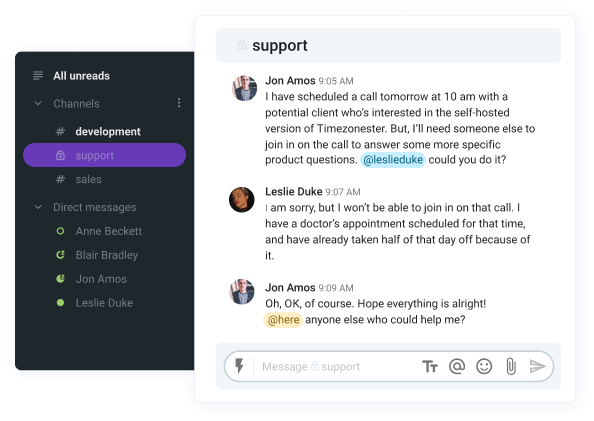There are well over 100 journals that deal with the topic of communication exclusively. Yet not one of them has published a paper called the 7 principles of communication or the 5 principles of communication or anything similar. The closest thing you can find is on WHO’s website, but while worth a read it’s hardly tailored to the specific communication challenges faced by remote workers.
But when we distill the definition of communication down to its most integral component, all that’s left is mutual understanding. Sure, you lose a lot of nuance during the distillation process, but you arrive at the core idea.
Therefore, the principles of communication are no more than tips on achieving mutual understanding, of which there are too many to count. Remote teams may have to employ some different methods, but the end goal is always the same.
With this in mind, this blog post aims to establish the definitive 10 principles of communication remote teams should follow by leveraging our considerable experience with this topic. But first, let’s take a look at some of the reasons why communication doesn’t always end in mutual understanding.

Table of Contents
Why is having clear principles of communication important?
Despite our assumption that what we say is exactly how people understand us, various communication barriers stand in the way of effective communication. Remote teams suffer from highly pronounced physical barriers, but they are not immune to any others. And given that many remote teams function on an asynchronous schedule, with employees possibly scattered across the world, language barriers and cultural barriers are also likely to cause some issues here. Unfortunately, this blog post won’t deal with the latter two barriers specifically. For that, you should check out our tips on perfecting cross-cultural communication.
Instead, what follows will be a checklist of 10 generalized communication principles that can help remote teams facilitate effective communication.
The 10 principles of communication
Understanding that the principles of communication have not been conveniently pre-packaged by academic journals — least of all the principles of communication for remote teams specifically — we offer our own 10 tips for improving the success rate of striking mutual understanding in this working environment.
1. Principle of concept
PREPARE AHEAD OF TIME
One of the upsides of working in remote teams is that you generally have enough time to prepare for communication before engaging in it. Research suggests that remote team communication is most effective when organized in rapid bursts, which are then followed by long periods of uninterrupted, or deep work. This, along with the study results that show video meeting fatigue sets in very quickly, means that remote workers need to have a more thoughtful approach to communication so as to reach a mutual understanding before meeting fatigue kicks in.
Organize your communication with Pumble
This is why we advocate the principle of concept as the first principle of communication remote teams should follow — and here’s how it goes.
Make sure that you are prepared by outlining exactly what it is you wish to communicate. If your presentation follows a certain outline and several people are following it, consider sharing the outline with them to give them a point of reference that will help them stay on track and follow you. This has the added benefit of preventing you from splitting into unnecessary tangents. But even the very act of articulating your goal to yourself can do a lot to help steer communication in the right direction.
2. Principle of clarity
AVOID BUSINESS JARGON
The principle of clarity is arguably the most important of the 10 principles. And unlike some others, we have complete control over it. We alone are responsible for the way we phrase our utterances. If we’re mindful of our goal (mutual understanding), then our choice of words should help us reach said goal. There are several ways in which you can do this, but they all follow this one simple rule: Avoiding prolixity.
Unless our goal here is to get you to Google the word prolixity (which it is, just to demonstrate a point, but let’s pretend it isn’t), then this would be a perfect example of what you shouldn’t do, which is use confusing vocabulary. Jargon can serve to make you appear more knowledgeable about a subject, but unless the person on the other end of the conversation is equally perspicacious on the given subject, most of what you say will come across as intellectual flimflam. You’re more likely to cause gargalesthesia or come across as a morosoph, so don’t be obdurate about this. If you’re this type of communicator, a profound metanoia about communication will do wonders in helping you strike mutual understanding.
To rephrase the previous paragraph in a way that doesn’t sound pretentious: Don’t use business jargon or unnecessarily complicated words that obscure meaning or otherwise obstruct communication. Sure, they may make you appear smarter, but the goal isn’t to appear smarter; the goal is to establish mutual understanding. This type of talk can only serve to turn the audience into passive listeners. If you want to be understood, you must find ways of communicating your intentions in a clear and easily understandable way.
3. Principle of attention
LISTEN ATTENTIVELY
No matter how well put together a sentence is, it won’t do us much good if we’re bad listeners.
This is why focusing on ways you can improve your listening skills is paramount to effective communication.
We can extend the phrase listening skills to entail everything the person on the receiving end of communication does.
As Alex Goryachev put it in his Forbes article on innovation and communication: “People listen mostly to respond, rather than to understand.” In short, there can be no collaboration without communication, and there can be no communication without listening. Leaders, in particular, have a lot to gain from listening to what their subordinates have to say and evaluating all their accumulated suggestions before retaking the reins of the conversation.
For something less abstract, here is the first step you should take in order to become a better listener:
Don’t jump to conclusions!
This is a proclivity no one is immune to. We like to play detectives. The sooner we can infer a conclusion from scattered pieces of information, the better we feel about our deduction skills. It’s as if figuring out what the other person means is more important than listening to them and letting them arrive at their conclusion. But this is no way to treat communication, especially in a remote team.
It bears noting that communication is not a race against time. Even if it were a race against time, in cases of bomb defusal, you’d still be better off attentively listening to the person on the other end of the line and not jumping to conclusions and cutting the wrong wire! Be patient and let the other person make their points. This way, the conclusion will find you.
4. Principle of assertiveness
COMMUNICATE ASSERTIVELY
“If you want something done right, do it yourself.”
You’ve all heard this quote. It really is a terrible mindset to take with you in any team, least of all a remote one. But while communication is a two-way street, there certainly are things you can do to motivate attentiveness in people you’re communicating with. The best advice we can give is to be more assertive in communication with your remote team.
For example, while conversing in person, we would normally reaffirm our interest in the subject and the interlocutor by looking them in the eyes. Remote workers usually only see eye to eye during video conference calls, but here, to achieve the same effect you should instead look directly at your camera. If you look the person in the eye on your display, you’ll appear to be looking elsewhere. Of our 9 tips for assertive communication in remote teams, this one is by far the most unintuitive, but it yields results.
The healthy communication environment that assertive communicators promote makes others more likely to engage in the conversation and understand our points. Assertiveness also lends itself well to written communication, where miscommunication is even likelier to occur without it.
5. Principle of feedback
AFFIRM MUTUAL UNDERSTANDING
Assuming that your message has been understood just the way you intended is not a good habit to get into. It helps to remind yourself that communication is comprised of three distinct parts: the sender, the message, and the receiver. Brelo’s model of communication takes this several steps further by outlining the following six steps of communication:
- The communications source (in this case you)
- The encoding of the message
- The message
- The delivery method of the message
- The decoding of the message
- The message receiver
As you can see, not only are the sender and the message clearly not one and the same, but the receiver is plenty distant as well.
Integrating the principle of feedback into your communication can feel unnatural, but nothing can inform you of the success or failure of establishing mutual understanding quite like it.
The way to implement it is quite simple — you ask the other person to repeat what they understood. If they get it right, you give them the a-okay. If they get it wrong, you attempt to communicate your idea again and ask them to repeat it once more.
To illustrate how this works, we can turn back to our bomb defusal example, where the person cutting the wires would be better off confirming that they understood the technician correctly before clenching the pliers.
As with looking into the camera during conference calls, this will require an upfront investment of effort, but the more you do it, the more casual you and everyone else will become about it. Furthermore, it won’t take long for this type of feedback to prove itself useful — it has the power to defuse miscommunication before any problems arise, at which point everyone will understand its usefulness and be more open to participating.
Explore Pumble’s Video Conferencing feature
6. Principle of informality
USE INFORMAL COMMUNICATION CHANNELS
One of the steps in Brelo’s model of communication is the delivery method of the message. A message with the same content will be communicated differently depending on the medium used. Formal communication channels like emails or formal one-on-ones may well be the first association for business communication that comes to mind, but among remote teams, informal communication channels (better known as grapevine communication) have proven more effective.
To this effect, many remote teams turn to a business messaging app, like Pumble — which can be used both by management as an official channel of communication and by all employees as an informal communication channel. Pumble not only facilitates faster communication but can also tap into the other benefits of informal workplace communication, such as team-building and feedback facilitation. Outside of using a team messaging app, adhering to the principle of feedback is all but impossible in remote teams. Can you even imagine trying that out via email?

7. Principle of consistency
DON’T BE MISLEADING
Likewise, it’s important to keep the contents and the tone of a message uniform. It’s been shown that, when misaligned, we tend to give more credence to the tone of a message than we do to its contents. You can substitute tone for any other cue of non-verbal communication and the results would be the same.
As illustrated above, if someone shouts “I am not angry” at you, in a tone of voice that unequivocally suggests they are angry, you’re not going to take their words at face value. Instead, you will infer the truthfulness of the message from its tone, i.e. you will understand that they are, in fact, angry.
This is just one mode of consistency to watch out for, and while it may not be the mode most often encountered at work, it serves as a fine example to illustrate the overall importance of tonal consistency.
Furthermore, you must look at whether the information you are communicating is consistent with previous information. If the directions management gives now are inconsistent with their previous directions, and they don’t elaborate on these inconsistencies or highlight what should take precedence, it will most certainly cause misunderstandings and confusion.
This has been proven on a large scale during the Covid-19 pandemic outbreak, when new and different preventative and safety measures were first being implemented, one after another, in a manner that can only be described as confusing.
8. Principle of rhetoric
LEARN TO BE PERSUASIVE
The goal of communication is often persuasion, be it persuading someone to click a link, buy your product, agree with your points of view, or anything else. The ancient-greek modes of persuasion (ethos, pathos, logos) have aided humanity in effective persuasion for thousands of years.
Nominally, these modes of persuasion are taught as integral parts of a good speech. However, you can use any combination of them in everyday communication. Here’s a quick refresher on what these concepts mean:
- Ethos is used to establish your credibility on the topic of the speech, either by providing your professional credentials or referring to the work or words of other professionals. For example, if you wish to dominate a topic on preventing workplace injuries, you can start your monologue by saying “As a physical therapist with decades of clinical experience,” or, (and this is more likely) “According to the Bureau of Labour Statistics (BLS).”
- Logos is used to appeal to the intellectual side of your brain, by providing facts and statistics. “According to BLS, a third of all worker injury or illnesses in 2013 were due to musculoskeletal disorders.” As you can see, ethos and logos go hand in hand when you cite sources to establish the authority of your argument.
- Pathos is a plea to the emotional side of the brain. “If nothing is done to improve workplace ergonomics, soon it will be your children who are developing symptoms of De Quervain’s tenosynovitis, or worse.”
Different people respond to different modes of persuasion. Pathos may not work on someone governed by logic, just like logos may prove ineffective on folks guided by emotions. Getting a handle on all of the basics will equip you for any argument.

Discuss, share, and collaborate on Pumble
9. Principle of timeliness
COMMUNICATE ON TIME
“A wizard is never late, nor is he early,” said Gandalf, the wise mentor from “The Lord of the Rings”. If you were a wizard, you could bank on the most opportune time to communicate conveniently coinciding with your earliest convenience. Alas, you are not a wizard, so bear this in mind: Not all information is better late than never. This is why many remote teams turn to team communication apps to help keep their members in sync.
Under the principle of concept, we’ve already mentioned how patterns for most effective conference call scheduling are emerging, but this isn’t the only way to communicate your thoughts and ideas.
Adhering to the principle of timeliness entails making efforts to ensure you communicate at the right time. Information that arrives too late can often be useless. On the other hand, information that arrives too early can easily be dismissed as irrelevant. The window you have for effectively communicating time-sensitive information is often shorter than the window you have to congratulate your friend’s or family member’s birthday without adding the dreaded belated — and we all know how well that turns out without making a conscious effort.
Just like wishing someone a happy birthday is timeliest on the actual date of their birthday, you should be aware that many business-related pieces of information have an expiration date. To this end, the use of a real-time team communication app is essential.

10. Principle of adequacy
OFFER COMPLETE MEANING
To make the meaning of your message as clear as you can, you must ensure that it is adequately complete. Unless you’re relying on luck, communicating a complete message gives you the best chance of reaching mutual understanding. But what does it mean for a message to be adequately complete? Well, consider the following example:
“I’m rescheduling the meeting that was due in 15 minutes for later this afternoon. Something came up. I’ve attached the outline for the meeting. Please familiarize yourself with its contents so that we can get through it more efficiently.”
On its own, this message is complete enough to communicate clear instructions to your team. Sometimes, this is all you want or need to do.
But if you’re looking to communicate your thoughts or feelings on a matter, the contents of the message should adequately reflect this — in other words, you have to be explicit.
If you want to let the other team members know you value their time and don’t feel good about this sudden inconvenience, you’ll have to add something like this: “It feels frustrating having to do this last minute.” Likewise, it may help to let the team know why they got stood up. Juggling remote work and parenting is an act many remote employees practice on a daily basis, so a reason such as “my daughter spilled piping hot water on her legs and I have to take her to ER” will help signal the urgency of your situation.
Again, it’s important to highlight that all versions of this message are complete in their own way. Making the message adequately means including all the info you want and expect others to know.
Uphold all 10 principles of communication with Pumble
What you say won’t always be a one-to-one translation of the idea you wish to convey, and the person on the other end of communication may interpret your words in a wholly different way.
But, luckily, with these 10 principles of communication, you can easily work around that problem.
To properly uphold all 10 principles we shared with you today, use Pumble, a team communication and collaboration app that allows you to seamlessly talk, share ideas, and cooperate with your entire organization.
With Pumble, you can organize your team communication so it’s:
- Clear, persuasive, and consistent, and
- Timely, assertive, and adequate.
What’s more, Pumble also offers you a great way to communicate both in a formal and informal way and offer and receive quick feedback to others.









